The trip to New Brighton, like the other trips mentioned above, was intended to observe changes since my previous trip to Liverpool and New Brighton on 17th November 2018 (post here). On the November trip, I'd seen that control of parts of the railway route in the Liverpool area had been transferred to the Manchester ROC (Rail Operating Centre) but I'd since read that, before Christmas 2018, further sections of the route had been transferred so I thought that a trip, armed with the Railcam.UK 'app' on my mobile phone (which is briefly described in my post Watching The Trains Go By) would clarify the present situation for me.
Getting there
I caught the 09:20 West Midland Trains 4-car Electric Multiple Unit from Wolverhampton to Liverpool Lime Street. After our Stafford stop, we remained on the Slow Line to Crewe. The train was booked into platform 11 but, checking the live signalling diagram on Railcam.UK, I noticed that platform 11 was already occupied. We slowed approaching Crewe South Junction but kept moving and stopped in platform 12 which sees occasional use. Because of the 'musical platforms' change, it was a few minutes before all the passengers waiting on platform 11 had made their way over the footbridge to join the train.
The train was quite full as we left Crewe, again routed on the Down Slow, allowing a Down 'Pendolino' to pass us before the two-track bottleneck at Winsford, where we picked up more passengers. With further stops at Hartford, Acton Bridge and Runcorn we had become quite crowded. At Liverpool South Parkway, we dropped a few passengers but picked up around the same number by which time I'd confirmed that the signal boxes at Halton Junction, Runcorn, Speke Junction and Allerton Junction had been 'abolished' with control now from Manchester ROC. Some existing signals had been renumbered with a new 'Control Code' followed by a 4-digit number (I assumed 'WE' was Weaver Junction to Liverpool Edge Hill). In other cases, completely new signals had been provided, like the example in the picture below.

Signal WE5831, platform 4 Liverpool South Parkway (New Brighton by rail).
However, as we approached the complex junctions around Edge Hill it appeared that, at present, the area remained an 'island' of earlier technology. Elderly (and in some cases, rusting) 3- and 4-aspect conventional colour light signals supplied by Westinghouse still labelled 'LE' remained in use as, presumably, was the modernistic 'panel box' at Edge Hill. But the signalling in Edge Hill Cutting and Lime Street Station itself has been renewed as part of the Lime Street re-modelling and control is now from Manchester ROC. The former Lime Street signal box, on our left as we slowed to a stop in the platform, showed signs of the internals being stripped.
As usual, I purchased a 'Saveaway' day ticket and descended to the Merseyrail underground platform at Lime Street. Normally, I take the train to James Street and then walk to the Museum of Liverpool to check on their star railway exhibit 'Lion'. Not wishing to be completely predictable, I instead continued under the River Mersey as far as Birkenhead North on a West Kirby service. Incidentally, I'd discovered that Rock Ferry was currently the limit of trains on the Chester Line. From there, two bus services (one All-stations, one Direct) were then serving Hooton where rail services were resumed but I didn't discover the reason. I left my West Kirby train at Birkenhead North station built by the Wirral Railway. There's a Wikipedia article on the Wirral Railway here.

New Brighton by rail: Birkenhead North station (Merseyrail).
Before boarding the following train to New Brighton, I had time to notice the stone carving on one gable end of the neat, brick station building on the Down side showing the Wirral Railway's 'blazon', which I confirmed afterwards by reference to the 'Heraldry of the World' site here.
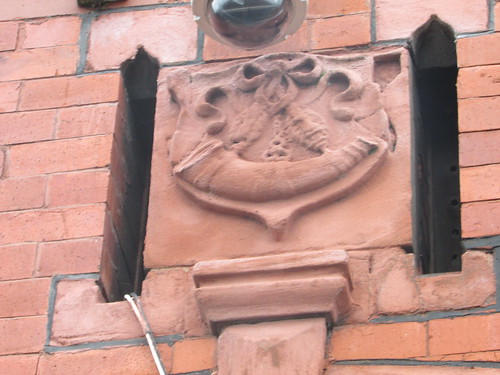
Wirral Railway carving, Birkenhead North station (Merseyrail).
The weather was overcast but surprisingly warm when I arrived at New Brighton's attractive station, offering a pleasant walk along Victoria Road then Victoria Parade to the promenade. I couldn't resist taking a picture of a telephone lineman at work.
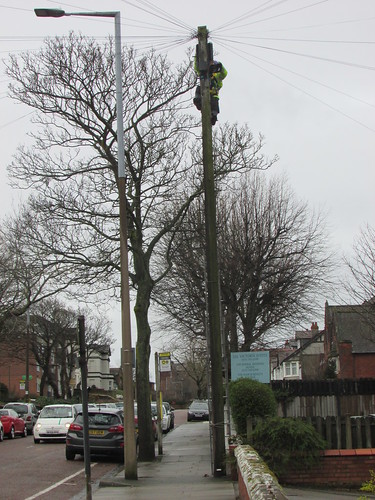
'Openreach' Lineman working on a British Telecom Distruibution Pole in Victoria Road, New Brighton (New Brighton by rail).
As you approach the front, the view is now dominated by the huge, red-painted container cranes on the other side of the Mersey at the deepwater dock called 'Liverpool 2'. A group of young people in wet suits were enjoying themselves on the sandy New Brighton beach.
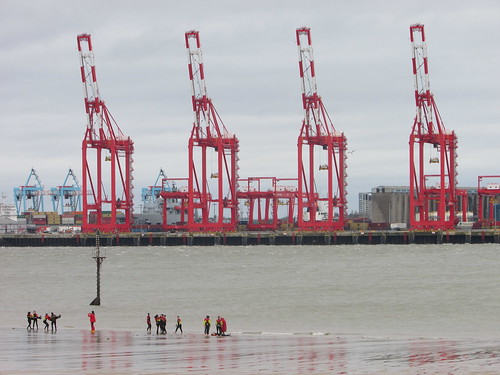
New Brighton by rail: View of Liverpool 2 Dock from New Brighton, with a group of young people in wet-suits on the beach.
I walked towards Fort Perch Rock, where there's a Ship's Radio Museum. Their website suggested that the museum was open at weekends. On the way, I took a picture of a small part of the alien-looking Burbo Bank Array of offshore wind turbines, together with a jack-up rig with its huge crane in the stowed position.

New Brighton by rail: Burbo Bank Array and Jack-up Rig.

New Brighton by rail: Fort Perch Rock.
Fort Perch Rock was, in fact, closed and "repelling all Boarders" so I chose to walk along the Promenade up-river to Seacombe. At over 2 miles in length, it's reputed to be the longest promenade in the country. I'd made the walk in the opposite direction on 29th December 2015 (there's a post here). Not long after starting my walk, 'Stena Mersey' (a passenger/freight 'Ro-Ro' ferry) silently passed, heading for the Irish Sea and Belfast.
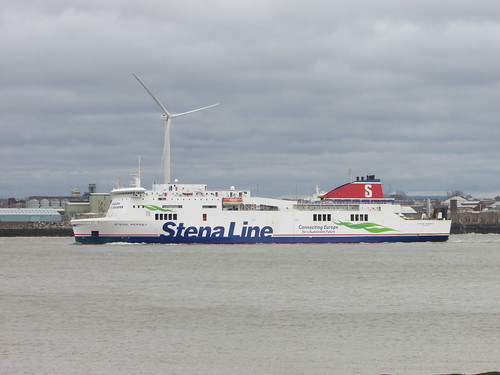
New Brighton by rail: 'Stena Mersey' passes New Brighton, outbound from Twelve Quays.
Further on, I was pleased to see the 'pirate ship' 'Black Pearl', constructed from driftwood, still entertaining children.
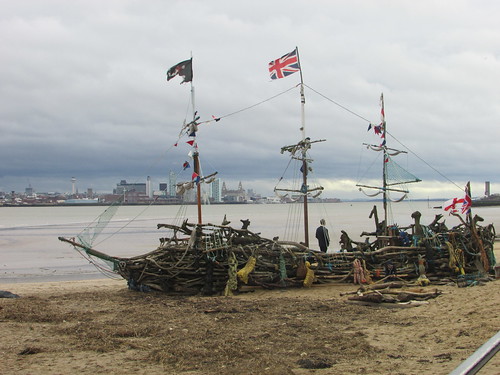
New Brighton by rail: The 'Black Pearl' art installation for children.
On my right, I passed Vale Park. Within the park, Vale House, built circa 1830, was for over 50 years the family home of Charles Holland, a Liverpool businessman and Wirral Justice of the Peace. Holland travelled widely and returned with botanical specimens that his gardeners planted. Vale House is now a community café & tea-room. I resisted the the temptation to linger, as I'd a fair walk ahead of me and my plan was to arrive at Seacombe in time to catch the hourly Mersey Ferry back to Liverpool Pierhead.
A spacious, tiled shelter on the landward side of the promenade next to Vale Park carried a blue plaque:-
Dr Dominic Joseph PoggiI loved the vagueness of "on or about" and "one or both".
29th August 1811 to 15th October 1880
This Shelter marks the position of
Dr Poggi's New Brighton College
which was burnt down on or about 27th
October 1862. The family were given shelter
by Mr Holland a magistrate who owned
Vale House. The Great Italian liberator
General Garibaldi had two sons; one or
both were educated at the College.
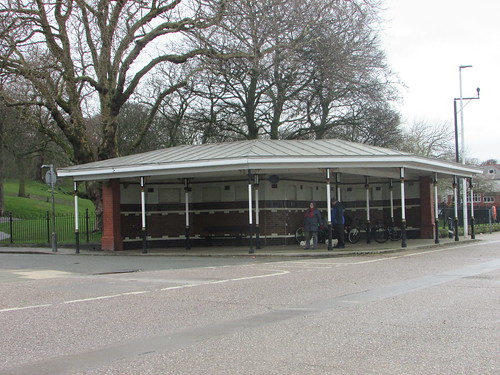
Shelter on the site of Dr Poggi's College (New Brighton by rail)
Earlier in my walk, I'd seen another 'Ro-Ro' ferry extricating itself from Liverpool Docks. Manoeuvring complete, it was now heading downstrean and I was able to identify it as 'Seatruck Power'.
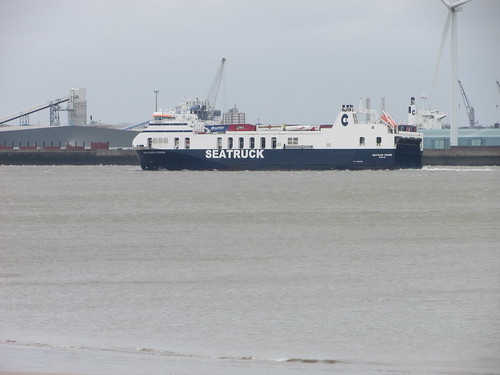
New Brighton by rail: 'Seatruck Power' outbound, viewed from Egremont.
In the post Watching The Ships Go By, I talked about the views around Liverpool available on the 'Wirralcam' site. One of the cameras is at Egremont, so I took a picture of the installation at 'Captain's View'.

'Wirralcam' installation on balcony of 'Captain's View', Egremont (New Brighton by rail).
I decided to attempt another 'selfie via the internet' but, as I set it up, the weather deteriorated, becoming quite dark and with intermittent rain, so the result was scarcely worth the trouble.
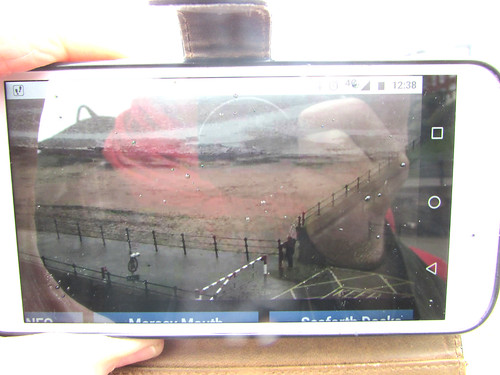
'Wirralcam' viewed on my mobile 'phone under rather poor conditions. The solitary figure just visible at the top of the concrete ramp leading to the beach is myself (New Brighton by rail).
The rain stopped more or less as soon as I continued my walk. This time, as I passed the impressive bulk of Wallasey Town Hall, I noticed that the gardens around the building were dedicated to the 96 people who lost their lives at Hillsborough Football Stadium, Sheffield on 15th April 1989.

New Brighton by rail: Wallasey Town Hall.
I could see the ferry I hoped to catch starting its crossing from Liverpool so that encouraged me to keep going. I took a picture of a naval ship moored on the Liverpool side but it was not until afterwards that I could identify it as HMS 'Enterprise' a "a multi-role hydrographic vessel".
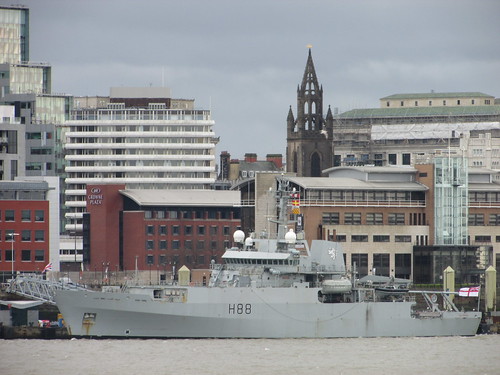
View of Liverpool from Promenade by Wallasey Town Hall, showing HMS 'Enterprise', H88, a multi-role hydrographic vessel built 2002 (New Brighton by rail).
With my destination in sight, I hurried past the huge ventilation tower on the Kingsway Road Tunnel. I arrived at Seacombe Ferry in plenty of time.

New Brighton by rail: Seacombe Ferry Building, opened 1933 listed Grade II.
When I obtained the 'boarding pass' for the ferry I was surprised to be told that boarding would be via the upstream access 'bridge'. So that the ferry can operate at all states of the tide, the actual landing stage is a floating pontoon connected to the shore by two 'bridges' also used for access which are articulated at each end allowing the pontoon to rise and fall with the tide. In the past, the downstream access bridge was normally used, resulting in money having been spent on making that approach a little more 'user friendly'. But, on this occasion, the upstream access bridge was in use - clean and perfectly adequate but a little more basic.

New Brighton by rail: Seacombe Ferry access bridge to Landing Stage with 'Royal Iris' arriving in background.
The afternoon ship's bridge crew (Captain and First Officer, I assumed) also joined the 'Royal Iris' ferry as the handful of passengers boarded. Soon, we were heading upstream towards the landing stage at Birkenhead Woodside, passing yet another 'Ro-Ro' ferry moored at Twelve Quays, 'Stena Forecaster'.
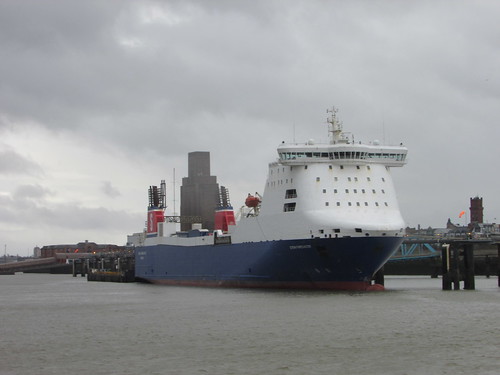
New Brighton by rail: 'Stena Forecaster' berthed at Twelve Quays.
The wind on the open deck which I normally prefer was quite strong and only a few hardy souls were with me. I managed a picture of what I assume was the pump house for the massive locks leading to the Great Float at Birkenhead.
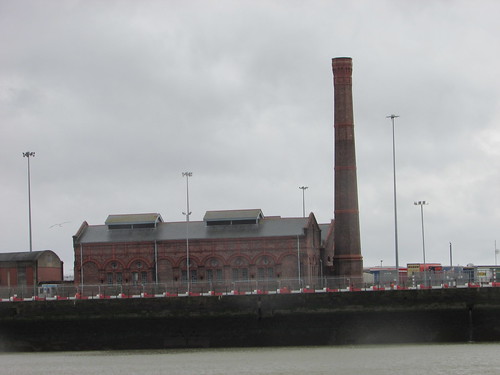
New Brighton by rail: Birkenhead Docks, showing pump house.
Quite a number of passengers left or boarded the ferry at Woodside.
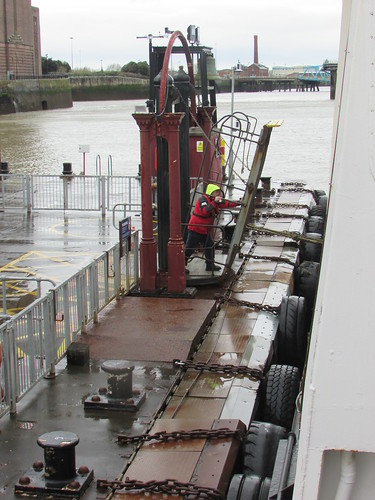
Boarding ramp at Woodside landing stage, viewed from Mersey Ferry.
We left the landing stage and continued upstream a little, offering the chance to see what was going on at the famous Cammell-Laird shipyard. The 'Tide' class replenishment tanker RFA Tidespring (A136) was visible in one of the basins. There's a Wikipedia article about this vessel here.
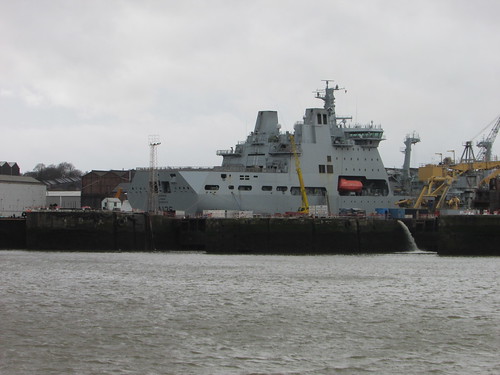
New Brighton by rail: the Cammell-Laird Shipyard viewed from the Mersey Ferry, showing RFA Tidespring (A136).
The new polar research vessel 'Sir David Attenborough' was also visible being fitted-out. Wikipedia have an article here about this ship.
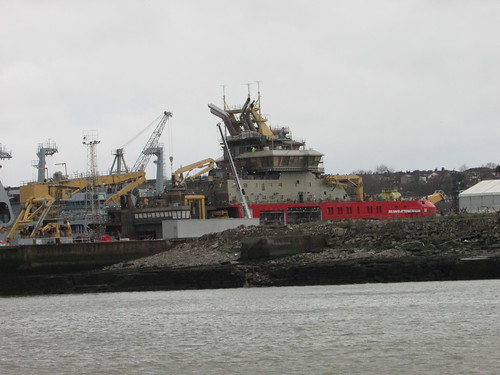
New Brighton by rail: the Cammell-Laird Shipyard viewed from the Mersey Ferry, showing RRS 'Sir David Attenborough'.
A little further upstream, at Tranmere Oil Terminal, the tanker 'Torill Knutsen' was berthed. I was puzzled because I could see a large steel structure attached to the bow whose function I could only guess at. On my return, a little bit of internet research confirmed that my guess was correct. The 'Torill Knutsen' is called a 'Shuttle Tanker', intended for ferrying product from offshore production facilities where the cost of a pipeline to land is not economic. There's a little more about the Knutsen OAS Shipping tanker fleet here. But I would never have guessed the significance of 'KNOT' painted on the hull. Apparently, in 2010 a Joint Venture with the Japanese conglomerate NYK was called Knutsen NYK Offshore Tankers - KNOT.

New Brighton by rail: 'Torill Knutsen' shuttle tanker berthed at Tranmere Terminal, viewed from Mersey Ferry.
The ferry had now crossed towards the Liverpool shore and we sailed downstream towards Pierhead landing stage, passing the huge Anglican cathedral
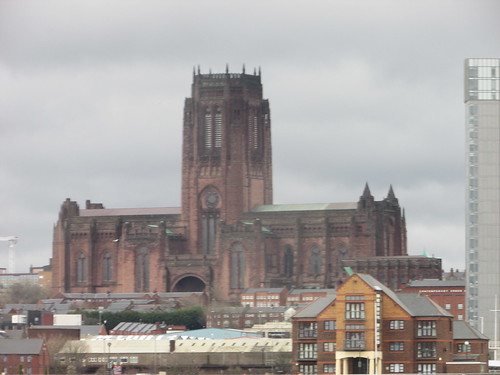
New Brighton by rail: Liverpool Anglican Cathedral viewed from Mersey Ferry.
On the approach to Pierhead, we passed close to the delightful Pilotage Building and the dreadful modern Museum of Liverpool building (don't get me started ...)

New Brighton by rail: Museum of Liverpool and the Pilotage Building viewed from Mersey Ferry.
We docked on time and it was only on disembarking that I realised how busy the service had been, since most passengers had avoided the rather windswept open deck areas.

'Royal Iris' docking at Liverpool Pierhead.
As usual, I had thoroughly enjoyed my river trip but I was definitely tiring so decided I'd better not delay my return home. I walked to James Street Merseyrail Station and descended to the platform in one of the huge electric lifts. Just two stops took me to Lime Street Station. In the main line station, the next service home was already waiting in platform 7. Before departure, I had time to walk the length of the platform. Looking back, my 4-coach Electric Multiple Unit looked lost inside the spacious, airy train shed (a similar train shed alongside covers the local platforms).
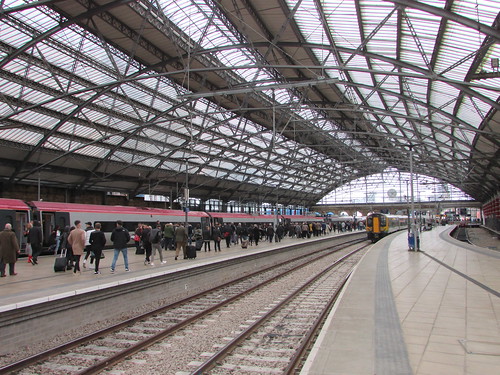
New Brighton by rail: Liverpool Lime Street Station.
As I studied the new LED colour light signals, a 'Pedolino' service from Euston arrived in platform 9 and disembarking passengers streamed along the lengthy platform.
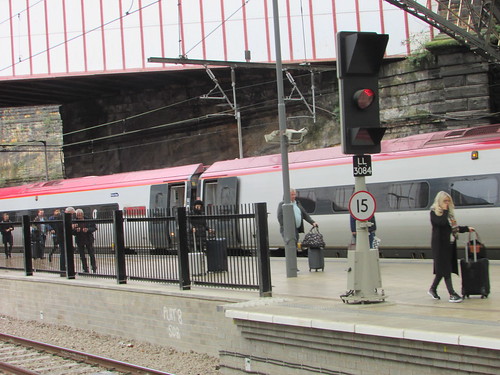
New Brighton by rail: Liverpool Lime Street Station.
On the return journey, I paid as much attention as possible to changes in the infrastructure but it had already become too dark for reasonable photographs. Another enjoyable day trip!
Related Posts on this Website
For me, Merseyside is a special place so there's a 'Label' to find everything I've written relating to the area (there are over 40 posts at the time of writing). Your can display all these posts, in reverse date-of-posting order, by selecting Label 'Merseyside' (or click here).
The following post describes my most recent prior visit to New Brighton on 17th November 2018:-
Another Trip to Merseyside.
My pictures
Where necessary, clicking on an image above will display an 'uncropped' view or, alternately, pictures may be selected, viewed or downloaded, in various sizes, from the albums below:-
In making my (often quite poor) pictures available on the internet, I have divided them into various albums each covering a roughly-defined geographical area. Within each album, photographs are normally arranged by date taken. Thus, by searching through the appropriate album, you can find changes through time. So, this trip to New Brighton added pictures to a number of albums as I moved through various areas.
The journey:
West Midland Railways (Wolverhampton).
Stafford Area rail.
Crewe Area rail.
Liverpool area rail (Winsford-Weaver Jn).
Warrington Area rail.
Merseyrail.
The destination:
Liverpool.
The Wirral.
